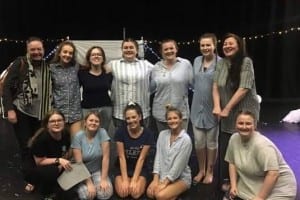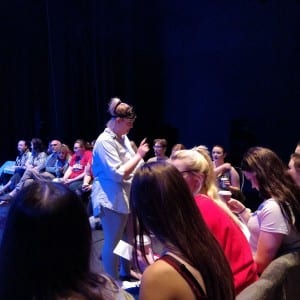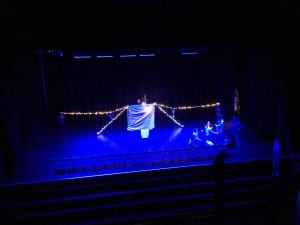Here are some of our technical documents, compiled by a range of our company members:
C.M.
Here are some of our technical documents, compiled by a range of our company members:
C.M.
We did it! Show day is complete!

Looking back and reflecting on Sherbet Lemon Theatre’s debut performance of The Truth About Bedtime… I can only beam with pride and joy. The response we have received, for me, can only be a testament for all of our hard work over the past 16 weeks.
As this may be my last blog post for a while, I wouldn’t want to spend it telling you the ins and outs of how show day went and how it can be improved for next time. However, if you’re a bit inquisitive like myself and would like to have peek at how things went, you can have a look at my stage manager performance report here.
Stage Manager Performance Report
I think for me, one of the greatest things to see happen on show day was our aspirations with our audience truly come to life. It has been a goal for all of us to really connect to our audience, ensure that they were comfortable and to spark feeling within them. I think this was recognised throughout all aspects of our performance, and the positive feedback we have been receiving only reaffirms this. Firstly, our intention of using verbatim engaged and connected us to our audience before we even stepped foot onto the stage. I believe that by using verbatim and engaging with the public before the show is a great way to ensure they feel a part of the show, especially through using their words within our performance. This element within itself, I believe, would meet Arts Council England’s (ACE) criteria perfectly. ACE articulate that they “invest public money to make great art that has an impact on everyone’s lives” (ACE, 2018). And what better way to include everyone? A show about sleep using verbatim!
We also extended our pre-set to half an hour, allowing enough time for our audience to come in and grab a hot drink, some biscuits and familiarise themselves with the space and the actors. This was achieved as one audience member commenting “the hot drinking chocolate and the blankets before the show were a really nice touch and I loved how the cast engaged with the audience before the show and during” (Donna, 2018).
For me and my job, I ensured that everyone with accessibility needs would be catered to on arrival. As engagement for everybody is vital to Sherbet Lemon Theatre, I ensured and liaised with Front of House that all people with accessibility needs, which was a total of four people, would not struggle when experiencing our performance. This was important to all of us as it further enables the inclusion of all people to engage with our production.

I am unbelievably happy with how everything went and how our audience perceived the show. Sherbet Lemon Theatre have had so much fun creating this, and on top of all of the great responses, I don’t think we’re ready to let The Truth About Bedtime… go just just yet. We’re currently in discussions about how and where we can go with show next, each time making the performance more inclusive for more people!
I have learnt a lot from stage managing this production, lots about communication and organisation, and will take this experience with me through my career.
Theatre is to be engaging and inclusive to everyone, and whether Sherbet Lemon Theatre do take The Truth About Bedtime… further or not, I have thoroughly enjoyed making the production inclusive to as many people as possible.
Sweet Dreams,
C.M.
Works Cited:
Arts Council England (undated) What We Do. London: Arts Council England. Available from https://www.artscouncil.org.uk/what-we-do-0 [accessed 25 May 2018].
McConnell, H. (2018) Sherbet Lemon Theatre after their debut performance. [image]
Lincoln School of Fine and Performing Arts (2018) We’re enjoying the pre-show hot chocolate and pyjama party at @SherbetLTheatre‘s show! [image]. Available from https://twitter.com/LSFPA_Lincoln/status/998630673618530304 [accessed 22 May 2018].
Donna, P. (2018) Comment left on blog post. Available from https://sherbetlemontheatre.blogs.lincoln.ac.uk/2018/05/22/show-day/#comment_count. [accessed 24 May 2018].
Hey everyone, we had a tech rehearsal!
I’d like to think it went quite well. As we would like to have an intimate atmosphere for The Truth About Bedtime…, our staging required to reflect that intimacy. So, our director requested we do not perform in proscenium arch and have our audience closer to the performance area. As stage manager, I am responsible for ensuring that any production ideas can come to life on stage so I had to confirm with Martin, LPAC stage manager, that flattening the auditorium would be possible in order to achieve an intimate atmosphere. This was confirmed, with fair warning that it would take up to two hours out of our scheduled time in the LPAC auditorium. I’m sure you can imagine that this was quite daunting as we only had four hours scheduled for a tech rehearsal, so we liaised that we would flatten the back end of the auditorium seating as that doesn’t take long at all, and we would still be able to fulfil our technical requirements in the space for our tech rehearsal.
Based on this information, I then created a schedule for tech day so I could ensure that our time in the space was used productively, and so that everyone knew what they were doing. Take a look at the schedule on the link below:
Sherbet Lemon Theatre Tech Schedule
When we first arrived I reaffirmed the staging requirements of the production with the technicians that we were working with. I was then advised that the previous vision of the audience facing the back of the auditorium would take even more unnecessary time out of tech rehearsal as we would have refocus all of the lights when we could still have the same intimate feel if we were positioned on the stage. The more I work as stage manager the more I realise that “communication is the main focus of the stage manager’s role” (Maccoy, 2014, 39). Therefore, I discussed this with our director and set designer and we decided it would be for the best to switch the position of our original staging as it would still have the same desired effect, and would be easier to tech.
The entirety of the tech rehearsal ran smoothly, all company members sticking to their assigned tasks for the duration. Earlier in the week, I organised a meeting with our set designer, Amanda, to ensure the assembling of the set can run as smoothly as possible. We decided it would be best to assign three people to assemble and dissemble the set. Upon discussion, we decided that Amanda would do it as she has designed the set and knows it very well, and Ellie (dramaturg) and Hayley (producer) as they are some of the company members who do not have specific duties on tech day and they showed an interest in the preparation of set. Having three people that are in charge of set assembling ensures a smooth and quick process. The three people who are in charge of set can now get it up in around 15 minutes which is important not just for the show at LPAC but for the future and tour-ability of the show, proving we can adapt to various get in times.
As I was extremely busy on tech day, our technical designer Chloe Denby, took photos on our behalf, here are some now:


Of course flattening out the LPAC auditorium space is going to take up a large part of our get in, which was daunting as this could be detrimental to the chance of a dress run on the show day. So, I discussed with the LPAC technicians if there would be any chance of a few of us coming into the auditorium Friday evening to flatten the space then, in order to take it out of our get in time. Once this was agreed I got in contact with the stage manager of Thinkbox Theatre to come in after their get out for for their show. We then agreed that once Thinkbox were coming to the end of their get out, we would have the chance to enter and flatten the space ready for our show on Monday.
From now until show day ,
C.M.
Works Cited:
Denby, C. (2018) Blue Lighting State.
Denby, C. (2018) Pink and Blue Lighting State.
Maccoy, P. (2014) Essentials of Stage Management. London: A&C Black.
So, I wouldn’t necessarily say I have a specific bedtime routine that I stick to every night. There are obviously some things that I do every night like brush my teeth because you know, I’m not disgusting.
I guess I’ve never really given myself a routine because I am usually one of the luckier ones who can take a duvet and a pillow and pretty much sleep anywhere if I’m tired enough. The weird thing is though, ever since starting the creative process for The Truth About Bedtime… I have definitely noticed a difference in my ability to sleep soundly every night. I still haven’t decided whether it’s because we’re spending so much time researching, creating and talking about what it means to sleep and therefore I’m thinking about it so much that when it comes down to it, I’m struggling. I am aware of course that alongside making the show I have SO much going on, with two other modules (one being the big D word that I don’t dare mention) as well as trying to figure out what I’m doing with my life after uni so yeah maybe it is because my mind is going 1000mph constantly and it’s not shutting down at night. So, yeah, maybe it’s that.
I guess you could say then my bedtime routine at the moment consists of changing into PJs, brushing my teeth and having a wee, checking my room thoroughly for a mouse (long story) and then getting into bed and falling asleep… eventually.
C.M.
Hey everyone,
We recently had a technical theatre session with Darren Page, LPAC’s technical coordinator. This was a session dedicated to all things technical that we would have to consider for the preparation and execution of our debut show, The Truth About Bedtime…

Although this was extremely handy for myself and our tech designer, it was really helpful for everyone when considering the decisions that were being made for the future of the show. We were reminded to look beyond the one assessed show that we were preparing for, and to always consider the future and how the company can prepare for the longevity of the production beyond the assessment. This encouraged us to think about the touring aspect of every decision we make. For example, as we are including a microphone and a stand in our piece, we were urged to consider pricing up a mic and stand for ourselves, so we would not need to ask every venue if they had a mic and stand, as this would be risky and potentially deal breaking. As we are still at early stages with the both the performance and the company we cannot guarantee that we will be pursuing it further, the use of a mic could even potentially change as we devise further, so buying a mic and stand may not be the best use of our budget at the moment.
The rest of the session was mainly a recap of all the technical documentation that is needed in preparation for a professional performance. I was aware of many of them due to previous modules such as Shakespeare and Production Skills. However, this session was really helpful as it had been a short while since I had to produce a lot of this documentation. We were informed of fundamental documents such as:
Many of these documents I had encountered before but we were introduced to a technical rider in this session which I had not come across before. A rider is documentation of all requirements of the production from technical equipment to dressing room needs. Barrel M. Kay stresses the importance of riders as “A touring company must send a sheet of specific requirements detailing their technical needs … to the presenter as a rider or attachment to the contract. The presenter reads the requirements and either agrees to them or reaches a compromise with the company” (M.Kay, 1991, 8). The importance of both parties knowing what is and is not being provided from both sides was also stressed by Darren who informed us of the specificity that had to go into a rider, especially in terms of technical lingo. This has inspired me to research different specific technical terminologies for what we may need to request from the tech team in LPAC so that I can create a well informed technical rider. For example, I know I will not state that we need one microphone, I will specify that we need a wireless SM58.
In brief, always consider the future and tour-ability of the show and learn the lingo for the rider. So, if we do decide to take the show further, I can guarantee that a “wireless SM58” will be at the top of our “To Buy” list.
C.M.
Works Cited:
Kay, M. (1991) The Technical Production Handbook: A Guide for Performing Arts Presenting Organizations and Touring Companies. New Mexico: Western States Arts Federation.
Morris, S. (2014) Technical Theatre. Arizona: Horizon High School Drama.